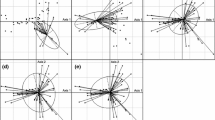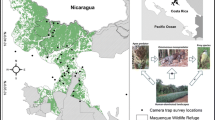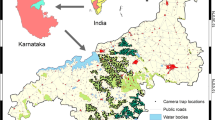Abstract
Understanding distributional patterns and mechanisms used by species for habitat selection is crucial to adopt effective land management policies in terms of biodiversity conservation. A heterogeneous landscape may allow coexistence of species. That coexistence will be dependent on the availability of the resources in the habitat that has to be sufficient to fulfil their basic needs. The present study aimed to investigate habitat selection, niche breadth and niche overlap of three sympatric carnivore species (Vulpes vulpes, Genetta genetta and Martes foina) in a typically fragmented landscape from Central Portugal, using camera-trapping techniques. The results obtained revealed that the investigated species use the available habitats differently and in a non-random way. The red fox showed the most specialized behaviour, positively selecting coniferous forests. The common genet preferred eucalyptus, avoiding old-growth mixed woodland, in contrast with stone marten that exhibited a strong preference for this late habitat, avoiding eucalyptus. Concerning the niche breadth, the genet had the highest value while the red fox had the lowest one. The results obtained at the camera-trap level showed that the highest niche overlap occurred between the genet and the stone marten which suggests that these species can coexist and share the available resources. Regarding the habitat level, the greatest niche overlap was found for the stone marten and the red fox, indicating the exploration of the same general habitat conditions by both species. The results obtained in the present study support the concept that landscape complexity allows coexistence between species within the same trophic level.


Similar content being viewed by others
References
Benson J, Chamberlain M (2007) Space use and habitat selection by female Louisiana black bears in the Tensas river basin of Louisiana. J Wildl Manag 71:117–126
Bignal E, McCracken D (2000) The nature conservation value of European traditional farming systems. Environ Rev 8:149–171
Brangi A (1995) Seasonal changes of trophic niche overlap in the stone marten (Martes foina) and the red fox (Vulpes vulpes) in a mountainous area of the Northern Apennines (N-Italy). Ital J Mammal 7:113–118
Cabral M, Almeida J, Almeida P, Dellinger T, Ferrand de Almeida N, Oliveira M, Palmeirim J, Queiroz A, Rogado L, Santos-Reis M (eds) (2005) Livro vermelho dos vertebrados de Portugal. Instituto da Conservação da Natureza, Lisboa
Cagnacci F, Meriggi A, Lovari S (2004) Habitat selection by the red fox Vulpes vulpes (L. 1758) in an Alpine area. Ethol Ecol Evol 16:103–116
Calzada J (2002) Genetta genetta (Linnaeus, 1758). In: Palomo L, Gisbert J (eds) Atlas de los mamiferos terrestres de España. Dirección General de Conservación de la Naturaleza-SECEM-SECEMU, Madrid, pp 290–293
Carvalho J, Gomes P (2004) Feeding resource partitioning among four sympatric carnivores in the Peneda-Gerês National Park (Portugal). J Zool 263:275–283
Cavallini P, Lovari S (1991) Environmental factors influencing the use of habitat in the red fox, Vulpes vulpes. J Zool 223:323–339
Cavallini P, Lovari S (1994) Home range, habitat selection and activity of the red fox in a Mediterranean coastal ecotone. Acta Theriol (Warsz) 39:279–287
Debinski D, Holt R (2000) A survey and overview of habitat fragmentation experiments. Conserv Biol 14:342–355
DGRF (2007) Inventário Florestal Nacional 2005/2006. Direcção-Geral dos Recursos Florestais, Lisboa
Fahrig L (2003) Effects of habitat fragmentation on biodiversity. Annu Rev Ecol Evol Syst 34:487–515
Fernández N, Delibes M, Palomares F (2007) Habitat-related heterogeneity in breeding in a metapopulation of the Iberian lynx. Ecography 30:431–439
Fischer J, Lindenmayer D, Manning A (2006) Biodiversity, ecosystem function, and resilience: ten guiding principles for commodity production landscapes. Front Ecol Environ 4:80–86
Franklin J (1993) Preserving biodiversity: species, ecosystems, or landscapes? Ecol Appl 3:202–205
Galantinho A, Mira A (2009) The influence of human, livestock, and ecological features on the occurrence of genet Genetta genetta: a case study on Mediterranean farmland. Ecol Res 24:671–685
Goldyn B, Hromada M, Surmacki A, Tryjanowski P (2003) Habitat use and diet of the red fox Vulpes vulpes in an agricultural landscape in Poland. Zeitschrift für Jagdwissenschaft 49:191–200
Hurlbert S (1978) The measurement of niche overlap and some relatives. Ecology 59:67–77
Karanth K, Nichols J (1998) Estimation of tiger densities in India using photographic captures and recaptures. Ecology 79:2852–2862
Kauffman M, Sanjayan M, Lowenstein J, Nelson A, Jeo R, Crooks K (2007) Remote camera-trap methods and analyses reveal impacts of rangeland management on Namibian carnivore communities. Oryx 41:70–78
Lanszki J, Kormendi S, Hancz C, Zalewski A (1999) Feeding habits and trophic niche overlap in a Carnivora community of Hungary. Acta Theriol (Warsz) 44:429–442
Levin S (1974) Dispersion and population interactions. Am Nat 108:207–228
Lucherini M, Lovari S (1996) Habitat richness affects home range size in the red fox Vulpes vulpes. Behav Process 36:103–105
Lucherini M, Lovari S, Crema G (1995) Habitat use and ranging behaviour of the red fox (Vulpes vulpes) in a Mediterranean rural area: is shelter availability a key factor? J Zool 237:577–591
Manly B (2002) Resource selection by animals: statistical design and analysis for field studies, 2nd edn. Kluwer, Dordrecht
Montgomery W (1980) The use of arboreal runways by the woodland rodents, Apodemus sylvaticus (L.), A. flavicollis (Melchior) and Clethrionomys glareolus (Schreber). Mamm Rev 10:189–195
Orians G, Wittenberger J (1991) Spatial and temporal scales in habitat selection. Am Nat 137:29–49
Otis D, Burnham K, White G, Anderson D (1978) Statistical inference from capture data on closed animal populations. Wildl Monogr 62:3–135
Padial J, Avila E, Sanchez J (2002) Feeding habits and overlap among red fox (Vulpes vulpes) and stone marten (Martes foina) in two Mediterranean mountain habitats. Mamm Biol 67:137–146
Paiva J (1998) A crise, apocalipse ou advento de uma nova idade, vol 1. Liga de Amigos de Conímbriga, Lisboa
Paiva J (2004) A relevante biodiversidade da mata. Monumentos 20:20–27
Palomares F (1990) Attempt of free ranging readaptation in two small carnivores in Doñana National Park. Mammalia 54:307–309
Palomares F, Delibes M (1988) Time and space use by two common genets (Genetta genetta) in the Doñana National Park, Spain. J Mammal 69:635–637
Palomares F, Delibes M (1994) Spatio-temporal ecology and behavior of European genets in southwestern Spain. J Mammal 75:714–724
Pianka E (1973) The structure of lizard communities. Annu Rev Ecol Syst 4:53–74
Pimm S, Rosenzweig M (1981) Competitors and habitat use. Oikos 37:1–6
Pulliam H, Danielson B (1991) Sources, sinks, and habitat selection: a landscape perspective on population dynamics. Am Nat 137:50–66
R Development Core Team (2010) R: a language and Environment for Statistical Computing. R Foundation for Statistical Computing, Vienna, Austria. ISBN 3-900051-07-0. http://www.R-project.org/
Ramil-Rego P, Muñoz-Sobrino C, Rodríguez-Guitián M, Gómez-Orellana L (1998) Differences in the vegetation of the North Iberian Peninsula during the last 16,000 years. Plant Ecol 138:41–62
Rexstad E, Burnham K (1991) User’s guide for interactive program CAPTURE. Abundance estimation of closed populations. Colorado State University, Colorado
Rondinini C, Boitani L (2002) Habitat use by beech martens in a fragmented landscape. Ecography 25:257–264
Rosalino L, Ferreira D, Leitão I, Santos-Reis M (2010) Usage patterns of Mediterranean agro-forest habitat components by wood mice Apodemus sylvaticus. Mamm Biol 76:268–273
Rosenzweig M (1981) A theory of habitat selection. Ecology 62:327–335
Rosenzweig M (1987) Habitat selection as a source of biological diversity. Evol Ecol 1:315–330
Santos M, Santos-Reis M (2010) Stone marten (Martes foina) habitat in a Mediterranean ecosystem: effects of scale, sex, and interspecific interactions. Eur J Wildl Res 56:275–286
Santos-Reis M, Santos M, Lourenço S, Marques J, Pereira I, Pinto B (2005) Relationships between stone martens, genets and cork oak woodlands in Portugal. In: Harrison D, Fuller A, Proulx G (eds) Martens and fishers (Martes) in human-altered environments: an international perspective. Kluwer, Dordrecht, pp 147–172
Sarmento P, Cruz J, Eira C, Fonseca C (2009) Evaluation of camera trapping for estimating red fox abundance. J Wildl Manag 73:1207–1212
Sarmento P, Cruz J, Eira C, Fonseca C (2010) Habitat selection and abundance of common genets Genetta genetta using camera capture-mark-recapture data. Eur J Wildl Res 56:59–66
Serafini P, Lovari S (1993) Food habits and trophic niche overlap of the red fox and the stone marten in a Mediterranean rural area. Acta Theriol (Warsz) 38:233–244
Silver S, Ostr L, Marsh L, Maffei L, Noss A, Kelly M, Wallace R, Gomez H, Ayala G (2004) The use of camera traps for estimating jaguar Panthera onca abundance and density using capture/recapture analysis. Oryx 38:148–154
SNIG (1995) Carta de Ocupação do Solo—COS’90. Instituto Geográfico Português, Lisboa
Such A, Calabuig G (2003) Dieta de la garduña (Martes foina Erxleben, 1777) en la Serra de la Solana (Sur del País Valencià). Galemys 15:167–180
Thompson W (2004) Sampling rare or elusive species: concepts, designs, and techniques for estimating population parameters. Island Press, Washington, DC
Trolle M, Kéry M (2003) Estimation of ocelot density in the pantanal using capture–recapture analysis of camera-trapping data. J Mammal 84:607–614
van den Berg L, Bullock J, Clarke R, Langston R, Rose R (2001) Territory selection by the Dartford warbler (Sylvia undata) in Dorset, England: the role of vegetation type, habitat fragmentation and population size. Biol Conserv 101:217–228
Vieira J, Pinto M, Pereira R (eds) (2000) Forests of Portugal. Direcção-Geral das Florestas, Lisboa
Virgós E, Casanovas J (1997) Habitat selection of genet Genetta genetta in the mountains of central Spain. Acta Theriol (Warsz) 42:169–178
Virgós E, García F (2002) Patch occupancy by stone martens Martes foina in fragmented landscapes of central Spain: the role of fragment size, isolation and habitat structure. Acta Oecol 23:231–237
Virgós E, Romero T, Mangas J (2001) Factors determining “gaps” in the distribution of a small carnivore, the common genet (Genetta genetta), in central Spain. Can J Zool 79:1544–1551
Virgós E, Telleria J, Santos T (2002) A comparison on the response to forest fragmentation by medium-sized Iberian carnivores in central Spain. Biodivers Conserv 11:1063–1079
Wiens J (1976) Population responses to patchy environments. Annu Rev Ecol Syst 7:81–120
Wilcove D, Rothstein D, Dubow J, Phillips A, Losos E (1998) Quantifying threats to imperiled species in the United States. Bioscience 48:607–615
Zabala J, Zuberogoitia I, Martínez-Climent J (2009) Testing for niche segregation between two abundant carnivores using presence-only data. Folia Zool 58:385–395
Acknowledgments
The authors would like to thank to T. Natal-da-Luz for English corrections, and to the anonymous reviewers who made helpful suggestions on an earlier draft of this manuscript.
Author information
Authors and Affiliations
Corresponding author
About this article
Cite this article
Pereira, P., Alves da Silva, A., Alves, J. et al. Coexistence of carnivores in a heterogeneous landscape: habitat selection and ecological niches. Ecol Res 27, 745–753 (2012). https://doi.org/10.1007/s11284-012-0949-1
Received:
Accepted:
Published:
Issue Date:
DOI: https://doi.org/10.1007/s11284-012-0949-1




